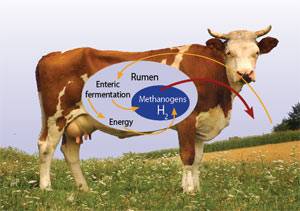A recent study (Burney et al, 2009) suggests that had humans not taken up the practice of widespread intensive farming we would indeed be much further along the climatic path of no return! In the study the authors build three models which represent different scenarios of agricultural advancement. One model is of our current reality whereby modern agricultural practices are in place, the second suspends agricultural yields at the levels of 1961 while increasing population and living standards and the third model is identical apart from also suspending living standards so that only population increases. Incredibly while fertilizer use would be lower, cropland would have to increase to nearly 1.8 billions hectares which dwarfs the 1.2 billion hectares that cropland currently takes up. Moreover the researchers believe the net effects of intensive agriculture have saved 161 gigatonnes of carbon since 1961!
 |
| Source: Burney et al, 2009 |
Studies have also investigated the current and future benefits to intensive animal farming. Havlik and others (2013) investigates the role of 'livestock production system transitions' (LPST) which are more efficient and less demanding livestock systems. They modeled a scenario of swift LPST against an imagined reality whereby consumption levels increased but livestock productions systems did not advance. They also looked into the role of LPSTs under different emissions mitigation strategies. The results were very promising. Simply transitioning to more efficient systems would save huge amounts of land from conversion and could subsequently reduce emissions by 736 million metric tons of carbon dioxide equivalent per year (MtCO2e·y−1) and if these systems were also put under only moderate mitigation policies 3,223 MtCO2e·y−1 after the year 2030. It is conceded that the establishment of such systems would face many barriers and could only occur with significant investment in market infrastructure.
As it so happens COP22 was held earlier this month and at the forefront of discussion was agriculture. Specifically 'regenerative' agriculture which outlines improvements to agricultural practices in the context of environmental change while also sustaining or even increasing production. At the heart of this is French Minister for Agriculture, Stéphane Le Foll's, 4 per 1000 initiative, which has the simple aim of increasing the quantity of carbon contained in soils by 0.04% every year. This increased quantity of carbon will be taking from the pool of atmospheric carbon and in doing so reduce climate change!
The science behind this is simple. Plant photosynthesis relies on sunlight, water and carbon dioxide. Fixing carbon as part of the photosynthetic process removes it from the atmosphere and eventually through plant decay this carbon will makes its way into soils as 'soil organic carbon'. Therefore the more the soil is covered by plant material the more carbon it will store.
Intensive farms contain massive amounts of biomass and, if managed well, could act as huge carbon sinks, removing carbon dioxide from the atmosphere.
The initiative outlines five key strategies towards reaching the 0.04% CO2 reduction goal:
1) Never leave soils bare and work them less
2) Introduce intermediate crops
3) Add to hedgerows and further develop agroforestry practices
4) Optimizing pasture management
5) Cultivate unused or poor land in arid and semi-arid regions.
The scope for this kind of farming is huge, especially when it is considered that better quality soils retain water better, are more resilient to erosion and most importantly produce higher quality crops, benefiting the farmer and the consumer.
So far 34 countries are signed on to the initiative with a large number of NGO's, research institutes, agricultural organisations and private sector companies. The outlook is promising. A very recent study (Yigini and Panagos, 2016) modeled a number of climate and land cover changes in Europe and found overall increases in soil organic carbon stocks by 2050. There's only one place that carbon could have come from!
Final thoughts...
It's difficult to associate vast industrial farms with climate change mitigation and so far I have only been able to see it as unavoidable in a world where food security is of utmost importance. In it's current state it is undeniable monoculture and animal supplementation are negatively impacting the environment however it is interesting to see that without industrial farming the impacts could be far worse. With political and economical will (easier said than done!) intensive farms could well be turned into zones of carbon sequestration which could at the least make the agricultural processes carbon neutral and at the very best could begin to reduce global atmospheric carbon dioxide, decrease land degradation and deforestation and provide global food security!
 |
| Source: http://www.seppo.net/cartoons/displayimage.php?pid=902 |




